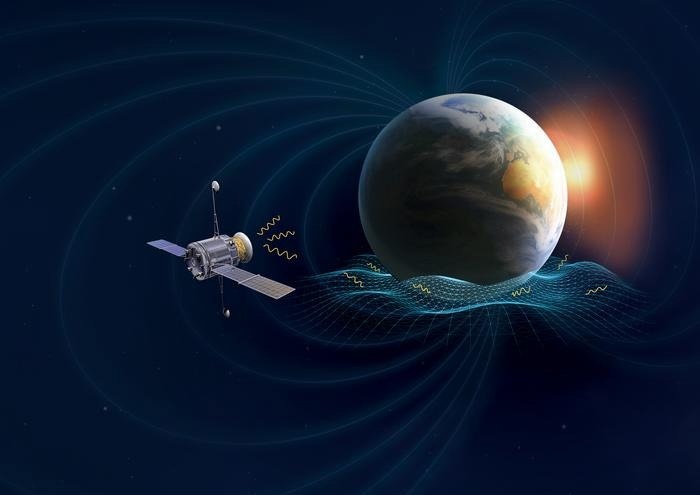Reviewed by Lexie CornerJun 7 2024
A research team from the Hong Kong University of Science and Technology (HKUST) led by Prof. Tao Liu, Associate Professor from the Department of Physics at the Hong Kong University of Science and Technology, has proposed a novel approach to detect high-frequency gravitational waves (HFGWs) for successful detection of HFGWs. This will create new avenues for investigating the early universe and violent cosmic events. The study has been published in the journal Physical Review Letters.
 The groundbreaking concept proposed by HKUST Department of Physics Prof. Liu’s team allows a single astronomical telescope in the Earth’s magnetosphere to function as a detector for GW signals. Image Credit: HKUST
The groundbreaking concept proposed by HKUST Department of Physics Prof. Liu’s team allows a single astronomical telescope in the Earth’s magnetosphere to function as a detector for GW signals. Image Credit: HKUST
Gravitational waves (GWs) are created by various astrophysical processes, including early universe phase transitions and primordial black hole collisions. However, their impacts are exceedingly faint and have only been identified using the interferometry technique in the relatively low-frequency band. Observing the cosmos with GWs, therefore, poses major technological problems, notably in probing the high-frequency range above one kilohertz, where the use of interferometry is severely limited.
To solve this issue, Prof. Tao Liu and his postdoctoral fellow, Dr. Chen Zhang, cooperated with Prof. Jing Ren of the Chinese Academy of Sciences' Institute of High Energy Physics, and their latest study resulted in a significant breakthrough. The study uses the fascinating physical effect in which GWs in a magnetic field can be transformed into potentially detectable electromagnetic waves.
The conversion efficiency is boosted by using the longer routes within the planetary magnetosphere, resulting in more electromagnetic wave transmissions. Due to the extensive angular spread of signal flux within such a planet laboratory, telescopes with a broad field of view can improve their detection capabilities even more.
This novel approach enables a single astronomical telescope to serve as a detector for GW transmissions. Combining numerous telescopes allows for a large coverage of HFGW frequencies, from megahertz to 1028 hertz.
This frequency range is similar to the electromagnetic spectrum employed in astronomical observations, and it contains a significant portion that has never been investigated in the detection of GWs before. The study gives an early estimate of sensitivity for satellite-based detectors in low Earth orbit as well as ongoing missions to Jupiter’s magnetosphere.
The study was published in Physical Review Letters in March and later featured by Nature Astronomy in an article headlined “Planet-sized laboratories offer cosmological insights” in May. This underscores the importance of the research in setting the way for future studies on innovative GW detection systems.
Journal Reference:
Liu, T., et al. (2024) Limits on High-Frequency Gravitational Waves in Planetary Magnetospheres. Physical Review Letters. doi:10.1103/PhysRevLett.132.131402